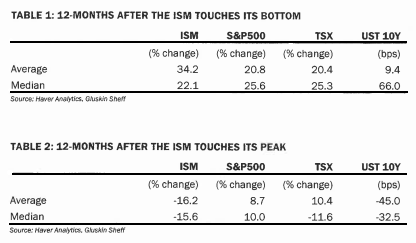This morning’s ISM services report has investors feeling reassured about the prospects of future economic growth and rightfully so. Despite the worse than expected results the latest readings are still consistent with economic expansion. The recent levels, however, are off their highs and given that this is a diffusion index it’s not unreasonable to expect some mean reversion in the index. Well, David Rosenberg has discovered an interesting correlation between falling ISM and markets – bond yields go down after the ISM peaks. He writes:
“It is an interesting commentary on what is already priced in at the troughs and peaks in the ISM index. We went back the past three decades and found that the best time to be buying equities and selling bonds is when the ISM is hitting bottom – as was the case in late 2008 and early 2009. The stock market is typically up 20% in the following year and bond yields are higher. But at the peak, where the ISM is now at just over the 60 level for the past three months, the stock market goes up by less than half the amount it does coming off the bottom and look at what the detested bond market does – it rallies.”
Update:
Lance Roberts, CEO of Streettalk Advisors sends along the following chart with some excellent thoughts on the current environment:
“This is an average of the ISM Non-Manufacturing Index and the Purchasing Managers Index. What is interesting is that you are now beginning to see signs of deterioration in both indexes as they approach levels that have historically been cycle peaks for the indexes. The concern here is that profit margins may be more impacted in the coming months than consensus estimates are currently expecting. Furthermore, we are seeing a turn down in the employment component which may not bode well for a continued advance in the employment indexes.”

Source: Gluskin Sheff & Streettalk Advisors
Mr. Roche is the Founder and Chief Investment Officer of Discipline Funds.Discipline Funds is a low fee financial advisory firm with a focus on helping people be more disciplined with their finances.
He is also the author of Pragmatic Capitalism: What Every Investor Needs to Understand About Money and Finance, Understanding the Modern Monetary System and Understanding Modern Portfolio Construction.


Comments are closed.